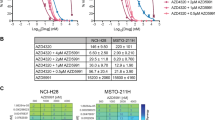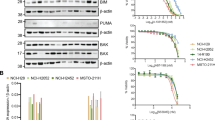Abstract
Purpose
Malignant pleural mesothelioma (MM), a rare tumor characterized by high local invasiveness and low metastatic efficiency, is poorly responsive to current therapeutic approaches. The aim of the present study was to evaluate the cytotoxic efficacy of the hybrid polar compound hexamethylene bisacetamide (HMBA), either as a single agent or in combination with the anthracycline doxorubicin (DOX), against MM cells.
Methods
The MM cell lines MM-B1 and MM-E1 were treated with HMBA, DOX or with combinations of the two drugs. Cell survival and death were assessed by the MTS assay and trypan blue staining/TUNEL, respectively. The interactions between drugs were evaluated by the method of Kern et al. Western blot analysis was used to investigate the expression of Bcl-2 family proteins.
Results
When administered alone, HMBA dose-dependently decreased the number of viable cells and increased the death rate of MM-B1 and MM-E1 cultures. Combinations of HMBA and DOX achieved a synergistic inhibition of MM cell survival, and the simultaneous administration of HMBA counteracted the resistance induced by DOX in MM-E1 cells. HMBA, used at cytostatic concentrations, reduced the ratio between antiapoptotic (Bcl-2, Bcl-XL) and proapoptotic (Bax) members of the Bcl-2 family of proteins, thus lowering the threshold for MM cell death commitment.
Conclusions
HMBA has therapeutic potential in MM both as a single agent and through potentiation of DOX toxicity. These results support future investigations on the feasibility of intrapleural chemotherapy with this hybrid polar compound.







Similar content being viewed by others
References
Andreeff M, Stone R, Michaeli J, Young CW, Tong WP, Sogoloff H, Ervin T, Kufe D, Rifkind RA, Marks PA (1992) Hexamethylene bisacetamide in myelodysplastic syndrome and acute myelogenous leukemia: a phase II clinical trial with a differentiation-inducing agent. Blood 80:2604–2609
Antman KH, Schiff PB, Pass HI (1997) Benign and malignant mesothelioma. In: De Vita VT Jr, Hellman S, Rosenberg SA (eds) Cancer: principles and practice of oncology, 5th edn. Lippincott-Raven, Philadelphia, pp 1853–1878
Attanoos RL, Gibbs AR (1997) Pathology of malignant mesothelioma. Histopathology 30:403–418
Bill CA, Vines CM, Garrett KC, Yamada K, Tofilon PJ (1990) Enhancement of the radiosensitivity of two human tumor cell lines by hexamethylene bisacetamide. Br J Cancer 61:563–567
Catalano A, Romano M, Robuffo I, Strizzi L, Procopio A (2001) Methionine aminopeptidase-2 regulates human mesothelioma cell survival: role of Bcl-2 expression and telomerase activity. Am J Pathol 159:721–731
Conley BA, Egorin MJ, Sinibaldi V, Sewack G, Kloc C, Roberts L, Zuhowski EG, Forrest A, Van Echo DA (1992) Approaches to optimal dosing of hexamethylene bisacetamide. Cancer Chemother Pharmacol 31:37–45
Dennis J, Bennet JP (2003) Interactions among nitric oxide and Bcl-family proteins after MPP+ exposure of SH-SY5Y neural cells I: MPP+ increases mitochondrial NO and Bax protein. J Neurosci Res 79:76–88
Fairbanks CA, Posthumus IJ, Kitto KF, Stone LS, Wilcox GL (2000) Moxonidine, a selective imidazoline/α2 adrenergic receptor agonist, synergizes with morphine and deltorphin II to inhibit substance P-induced behavior in mice. Pain 84:13–20
Gewirtz DA (1999) A critical evaluation of the mechanism of action proposed for the antitumor effects of the anthracycline antibiotics adriamycin and daunorubicin. Biochem Pharmacol 57:727–741
Greco WR, Bravo G, Parson JC (1995) The search for synergy: a critical review from a response surface perspective. Pharmacol Rev 47:331–385
Gross A, McDonnell JM, Korsemeyer SJ (1999) BCL-2 family members and the mitochondria in apoptosis. Genes Dev 13:1899–1911
Guilbaud NF, Gas N, Dupont MA, Valette A (1990) Effects of differentiation-inducing agents on maturation of human MCF-7 breast cancer cells. J Cell Physiol 145:162–172
Howard S, Bottino C, Brooke S, Cheng E, Giffard RG, Sapolsky R (2002) Neuroprotective effect of bcl-2 overexpression in hippocampal cultures: interactions with pathways of oxidative damage. J Neurochem 83:914–923
Isobe H, Wellham L, Sauerteig A, Sridar KS, Ramachandran C, Krishan A (1994) Doxorubicin retention and chemoresistance in human mesothelioma cell lines. Int J Cancer 57:581–585
Kern DH, Morgan CR, Hildebrand-Zanki SU (1988) In vitro pharmacodynamics of 1-β-d-arabinofuranosylcytosine: synergy of antitumor activity with cis-diamminedichloroplatinum(II). Cancer Res 48:117–121
Khan MZ, Freshney RI, McNicol AM, Murray AM (1993) Induction of phenotypic changes in SCLC cell lines in vitro by hexamethylene bisacetamide, sodium butyrate, and cyclic AMP. Ann Oncol 4:499–507
Licht T, Fiebig HH, Bross KJ, Herrmann F, Berger DP, Shoemaker R, Mertelsmann R (1991) Induction of multiple-drug resistance during anti-neoplastic chemotherapy in vitro. Int J Cancer 49:630–637
Marks PA, Richon VM, Kiyokawa H, Rifkind RA (1994) Inducing differentiation of transformed cells with hybrid polar compounds: a cell cycle-dependent process. Proc Natl Acad Sci U S A 91:10251–10254
Mercatante DR, Bortner CD, Cidlowsky JA, Kole R (2001) Modification of alternative splicing of Bcl-x pre-mRNA in prostate and breast cancer cells. J Biol Chem 278:16411–16417
Miyashita T, Kitada S, Krajewski S, Horne WA, Delia D, Reed JC (1995) Overexpression of the Bcl-2 protein increases the half-life of p21Bax. J Biol Chem 270:26049–26052
Ogretmen B, Bahadori HR, McCauley MD, Boylan A, Green MR, Safa AR (1998) Co-ordinated over-expression of the MRP and γ-glutamylcysteine synthetase genes, but not MDR1, correlates with doxorubicin resistance in human malignant mesothelioma cell lines. Int J Cancer 75:757–761
Rajagopalan S, Rodrigues M, Polk T, Wilson D, Chader GJ, Hayden BJ (1993) Modulation of retinoblastoma cell characteristics by hexamethylene bis-acetamide and other differentiating agents in culture. J Histochem Cytochem 41:1331–1337
Richon VM, Webb Y, Merger R, Sheppard T, Jursic B, Ngo L, Civoli F, Breslow R, Rifkind RA, Marks PA (1996) Second generation hybrid polar compounds are potent inducers of transformed cell differentiation. Proc Natl Acad Sci U S A 93:5705–5708
Rihn BH, Mohr S, McDowell SA, Binet S, Loubinoux J, Galateau F, Keith G, Leikauf GD (2000) Differential gene expression in mesothelioma. FEBS Lett 480:95–100
Romanelli S, Perego P, Pratesi G, Carenini N, Tortoreto M, Zunino F (1998) In vitro and in vivo interaction between cisplatin and topotecan in ovarian carcinoma systems. Cancer Chemother Pharmacol 41:385–390
Ruefli AA, Smyth MJ, Johnstone RW (2000) HMBA induces activation of a caspase-independent cell death pathway to overcome P-glycoprotein-mediated multidrug resistance. Blood 95:2378–2385
Scarpa S, Giuffrida A, Fazi M, Coletti A, Palumbo C, Pass HI, Procopio A, Modesti A (1999) Migration of mesothelioma cells correlates with histotype-specific synthesis of extracellular matrix. Int J Mol Med 4:67–71
Schroy PC, Rustgi AK, Ikonomu E, Liu XP, Polito J, Andry C, O’Keane JC (1994) Growth and intestinal differentiation are independently regulated in HT29 colon cancer cells. J Cell Physiol 161:111–123
Shinoura N, Yoshida Y, Asai A, Kirino T, Hamada H (1999) Relative level of expression of Bax and Bcl-XL determines the cellular fate of apoptosis/necrosis induced by the overexpression of Bax. Oncogene 18:5703–5713
Siegel DS, Zhang X, Feinman R, Teitz T, Zelenetz A, Richon VM, Rifkind RA, Marks PA, Michaeli J (1998) Hexamethylene bisacetamide induces programmed cell death (apoptosis) and down-regulates BCL-2 expression in human myeloma cells. Proc Natl Acad Sci U S A 95:162–166
Smythe WR, Mohuiddin I, Ozveran M, Cao XX (2002) Antisense therapy for malignant mesothelioma with oligonucleotides targeting the bcl-xl gene product. J Thorac Cardiovasc Surg 123:1191–1198
Soini Y, Jarvinen K, Kaarteenaho-Wiik R, Kinnula V (2001) The expression of P-glycoprotein and multidrug resistance proteins 1 and 2 (MRP1 and MRP2) in human malignant mesothelioma. Ann Oncol 12:1239–1245
Sterman DH, Kaiser LR, Albelda SM (1999) Advances in the treatment of malignant pleural mesothelioma. Chest 116:504–520
Tesei A, Ricotti L, De Paola F, Amadori D, Frassineti G, Zoli W (2002) In vitro schedule-dependent interactions between the multitargeted antifolate LY231514 and gemcitabine in human colon adenocarcinoma cell lines. Clin Cancer Res 8:233–239
Uhm JH, Dooley NP, Kyritsis AP, Rao JS, Gladson CL (1999) Vitronectin, a glioma-derived extracellular matrix protein, protects tumor cells from apoptotic death. Clin Cancer Res 5:1587–1594
Ward FT, Kelley JA, Roth JS, Lombardo FA, Weiss RB, Leyland-Jones B, Chun HG (1991) A phase I bioavailability and pharmacokinetic study of hexamethylene bisacetamide (NSC 95580) administered via nasogastric tube. Cancer Res 51:1803–1810
Waxman S, Scher BM, Hellinger N, Scher W (1990) Combination cytotoxic-differentiation therapy of mouse erythroleukemia cells with 5-fluorouracil and hexamethylene bisacetamide. Cancer Res 50:3878–3887
Young CW, Fanucchi MP, Walsh TD, Baltzer L, Yaldaei S, Stevens Y, Gordon C, Tong W, Rifkind RA, Marks PA (1988) Phase I trial and clinical pharmacological evaluation of hexamethylene bisacetamide administration by ten-day continuous intravenous infusion at twenty-eight-day intervals. Cancer Res 48:7304–7309
Zellos LS, Sugarbaker DJ (2002) Multimodality treatment of diffuse malignant mesothelioma. Semin Oncol 29:41–50
Acknowledgements
This work was supported by MURST 60% grants. The authors are grateful to Dr. Carolina Malacrino for critical reading of the manuscript.
Author information
Authors and Affiliations
Corresponding author
Rights and permissions
About this article
Cite this article
Palumbo, C., Albonici, L., Bei, R. et al. HMBA induces cell death and potentiates doxorubicin toxicity in malignant mesothelioma cells. Cancer Chemother Pharmacol 54, 398–406 (2004). https://doi.org/10.1007/s00280-004-0838-6
Received:
Accepted:
Published:
Issue Date:
DOI: https://doi.org/10.1007/s00280-004-0838-6




